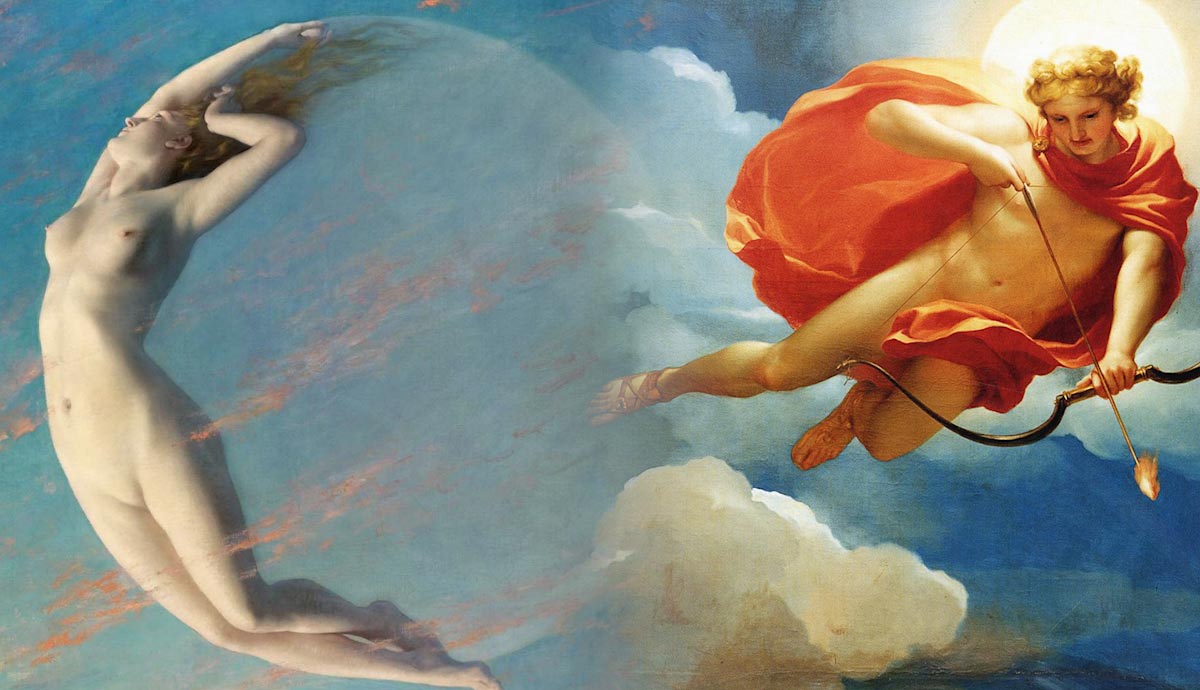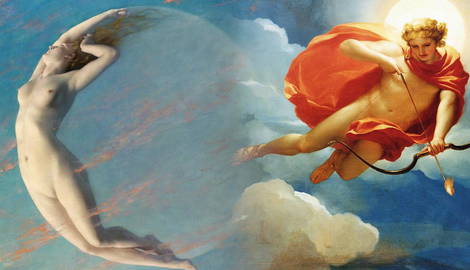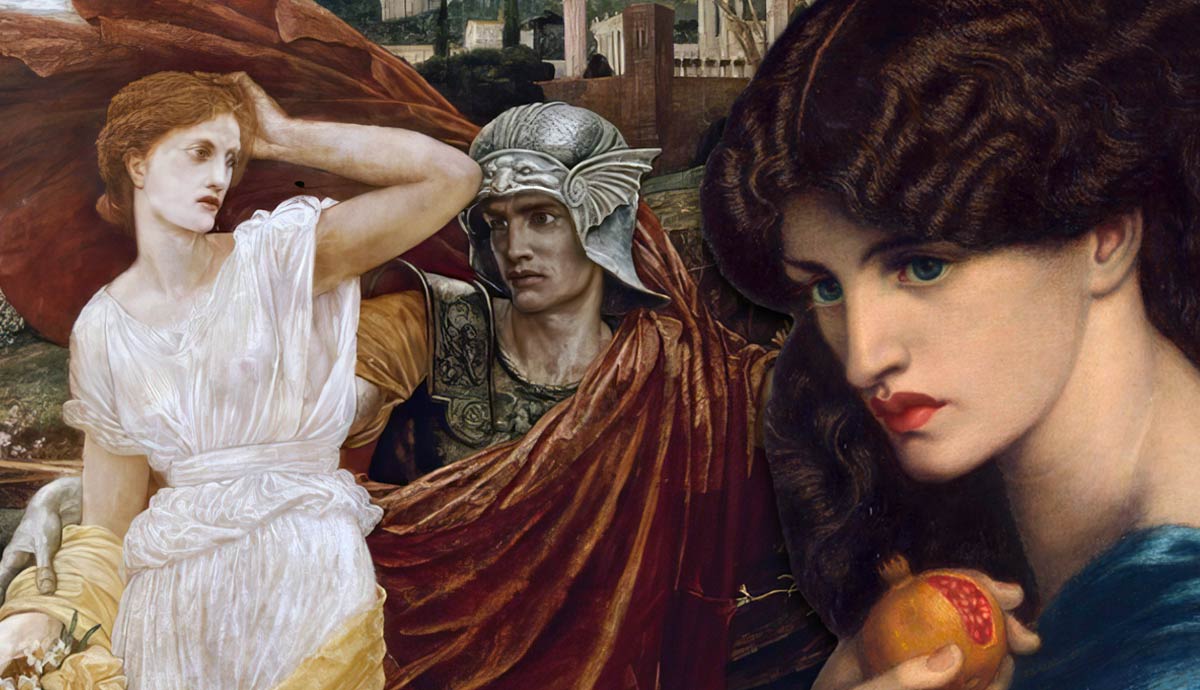
Religion in the Greek world focused on the 12 Olympian gods of Mount Olympus, led by Zeus. But the Greek pantheon contained thousands of deities. There were the ancient Titans, nature spirits, the Muses, personifications of natural phenomena, and many more entities considered divine and described in Greek myth. Read on to meet 12 of the lesser-known Greek gods and goddesses, their origins, stories, significance, and more.
1. Helios: God of the Sun

Son of the Titans Hyperion and Theia, Helios was the deity and personification of the sun. Visually, he was depicted as radiantly handsome with golden hair and shining eyes, wearing a crown of sun rays. He was said to have driven a chariot pulled by four fiery horses, beginning each day in the east before descending in the west. His ability to provide light and warmth was essential to the survival of crops, animals, and people.
Within Helios’ mythology, one notable story involves his son, Phaethon. In a moment of recklessness, Phaethon wanted to prove his lineage by driving his father’s chariot across the sky. However, lacking the skill for such a task, he quickly lost control of the fiery chariot, causing chaos and destruction. The earth was scorched, and Zeus was required to intervene by striking Phaethon down with a thunderbolt saving the world from further catastrophe.
2. Nyx: Goddess of the Night

Nyx, the enigmatic goddess of the night, is a figure shrouded in darkness and intrigue. Her origins can be traced back to the very beginning of Greek mythology when she emerged from the void of the universe as the first child of Chaos. With her long, flowing hair and starry robes, Nyx was a goddess whose very essence embodied the darkness of the night. Her black veil shrouded the earth, signaling the arrival of the night and the end of the day.
Nyx was considered to be the mother of numerous powerful deities in the elaborate genealogies described in Greek myth. She was the mother of Aether, Nemesis, the Moirai (fates), the Erinyes, Hypnos, and Thanatos. Regardless of her foreboding reputation, she was revered by many, particularly mortal women, who turned to her in times of need, seeking her protective powers and guidance. The night was also thought to be a time for introspection, contemplation, and spiritual connection.
3. Hypnos: God of Sleep

Nyx’s son, Hypnos, was the god of sleep, relaxation, and dreams, said to reside in the underworld with his twin brother, Thanatos. He is usually depicted with delicate wings, occasionally carrying a poppy flower, which was believed to have sleep-inducing properties.
As the personification of sleep, Hypnos possessed the unique ability to induce a sleeping state and bring forth dreams to both mortals and the divine rulers of the cosmos, from which they derived inspiration. One such instance occurred during the Trojan War when Hera, wanting to tip the scales of battle in favor of the Greeks, turned to Hypnos for assistance. She asked Hypnos to lull Zeus into a deep sleep so that she could influence the war without obstruction. This moment was a testament to Hypnos’ influence and power over even the king of the gods.
4. Iris: Goddess of Rainbows

In Greek mythology, Iris is a captivating figure, the goddess of rainbows, and the messenger of divine communication. As the daughter of Thaumas and Electra, she held a crucial role in bridging the mortal and divine realms. Descriptions often illustrate her as a young and graceful goddess adorned with vibrant, iridescent wings that shone with the colors of a rainbow. In Homer’s Iliad, Iris is frequently dispatched by the gods to deliver messages to the mortal heroes on the battlefield. She acts as a mediator, conveying the gods’ directives and influencing the outcome of major events.
5. Nike: Goddess of Victory

Nike, the Greek goddess of victory, was believed to bring good fortune and success to those who worshipped her. She was often shown hovering above battlefields in mythological scenes, assessing the conflict. In various other mythological scenes, she was shown as a miniature goddess in the hands of one of the Olympian gods, such as Zeus.
In her hands, she carried laurel wreaths, a symbol of honor and glory, which she was said to bestow upon the victors. With her status as the goddess of victory, Nike became an important deity to appease and worship. Her divine intervention was believed to bring good fortune, guiding individuals towards success and ensuring a favorable outcome in their deeds. Athletes, warriors, and individuals tackling challenging deeds sought the favor and blessings of Nike. Many temples and statues were erected in her honor, expressing her influence within Greek culture.
6. Hecate: Goddess of Witchcraft

Often depicted as a triple goddess with three heads or bodies, Hecate encompassed aspects of the earth, the underworld, and the heavens. She boasted a myriad of associations including sorcery, the moon, and the spirits of the dead. Her enigmatic nature and profound connection to the mystical arts made her the revered goddess of witches and occultists. Hecate’s dominion extended beyond the mortal realm, delving into the depths of the underworld and the mysteries of the afterlife.
At times, she assumed the role of protector of souls as they crossed into the realm of the dead; as such, she was often shown with two torches in either hand. In one version of Persephone’s abduction by Hades, Hecate played a pivotal role. She aided in Demeter’s search to find her missing daughter, utilizing her knowledge of the underworld to assist in the quest. After Persephone became the queen of the underworld, Hecate joined her as a loyal companion.
7. Nemesis: Goddess of Revenge

Nemesis was the goddess of retribution and vengeance, often invoked by those seeking to avenge a wrong or seeking justice for injustice. Typical images of Nemesis depict her carrying a whip or a sword, both symbols of authority and power. She served as a powerful reminder that every action has consequences, with those who committed wrongdoings facing the full weight of her divine retribution. Nemesis’ actions, though seemingly harsh, were considered an essential part of the natural cycle, ensuring that justice was upheld and wrongs were righted. She was regarded as a guardian of cosmic balance, maintaining order and fairness in the world. Her exaction of retribution restored equilibrium and prevented chaos from prevailing.
8. Selene: Goddess of the Moon

As the goddess of the moon, Selene was responsible for controlling the tides, as well as the cycle of the moon. Portrayed as an ethereal figure, she was described as a beautiful woman draped in flowing robes with a crescent moon on her forehead. Like her opposite deity, Helios, the sun god, in epic poems, she is said to have driven a chariot drawn by two horses into the night sky and cast a brilliant light upon the earth.
Sailors worshipped her presence, the moon’s light allowing them to navigate the ocean. Beyond her divine duties, Selene’s love affair with the mortal shepherd, Endymion, is a tale deeply intertwined with her mythological narrative. Entranced by Endymion’s beauty, Selene asked Zeus to grant immortality to her shepherd. This act of divine intervention immortalized their love, allowing Endymion to be eternally young and remain with Selene. It is reported that they ultimately had fifty daughters together.
9. Eris: Goddess of Strife

Eris embodies the essence of strife, turmoil, and discord. Her very existence serves as a reminder that conflict is an inherent part of human nature and the world. In her ancient form, she is shown to be a restless figure with disheveled hair and a wicked grin, displaying an aura of mischief.
Famously, at the wedding of Peleus and Thetis, Eris arrived with a golden apple inscribed with the words “For the Fairest.” This simple inscription ignited a fierce rivalry among the goddesses Hera, Athena, and Aphrodite, each fighting for possession of the coveted apple. The conflict, known as the Judgment of Paris, would ultimately lead to the Trojan War, a decade-long war notorious within mythology. Surprisingly, Eris’s chaotic tendencies also aligned with creativity and inspiration. She represented the catalyst to spark change, although sometimes destructive, ultimately pushing the world toward progress.
10. Asclepius: God of Medicine

As the god of medicine and healing, Asclepius was believed to have a deep understanding of both physical and mental health, called upon to heal sicknesses and injuries. Son of Apollo, he was raised by the wise centaur Chiron who taught him the ways of medicine. Asclepius was often shown as a bearded man holding a staff with a serpent entwined around it. This was called the Rod of Asclepius, which has become a symbol of modern medicine. It is said that the serpent represents renewal and rebirth, as it sheds its skin and emerges restored, just as patients can overcome illness.
Asclepius’ temples, centers of healing, were located throughout ancient Greece. Patients would visit the temples to seek guidance, diagnosis, and treatment from the priests. According to some mythological accounts, Asclepius had the ability to defy nature by resurrecting the dead. This act angered Zeus, who was said to have struck him down with a thunderbolt. However, recognizing Asclepius’ contributions to humanity, Zeus later immortalized Asclepius among the stars, as the constellation Ophiuchus.
11. Psyche: Goddess of the Soul

Psyche was the goddess of the soul in both ancient Greece and Rome and was usually depicted as a beautiful woman with butterfly wings. She was born a mortal woman but with the beauty to rival Aphrodite. This angered the goddess of love and beauty, who sent her son Eros to make her fall in love with a vile and hideous monster. Instead, Eros fell in love with Psych himself and married her, taking her to his divine home as his wife on the condition that she never try to see his face. When Psyche’s sisters came to visit her in her new palatial home, they convinced her that her husband must be a monster and she snuck into his room to discover his identity. She was expelled from his home and forced to wander the world looking for her love.
Eventually, Psyche made her way to Aphrodite, who agreed to help her if she accomplished a number of trials, including gathering water from the River Styx and shearing a golden fleece. When she was successful, Aphrodite reunited the lovers, and Aros asked Zeus to make Psyche immortal. She was given the ambrosia of the gods to drink and became the goddess of the soul. The most important source for the story is Apuleius’ Golden Ass.
12. Pan: God of the Wild

In Greek mythology, Pan was the god of the wild and the wilderness, as well as shepherds and their flocks. He has the head and body of a human and the hind legs and horns of a goat. Possibly a son of Hermes, was thought to come from the rustic region of Arcadia, where he could often be found playing music and partying with the nymphs in acts representing fertility.
As a rustic god imported from Arcadia, Pan was not worshiped in temples but in natural settings such as caves or grottoes. There was a cave of Pan on the north slope of the Acropolis in Athens. As a god that can be characterized as “other” and “wild,” Pan’s image and mythology influenced early depictions of the Christian devil.










